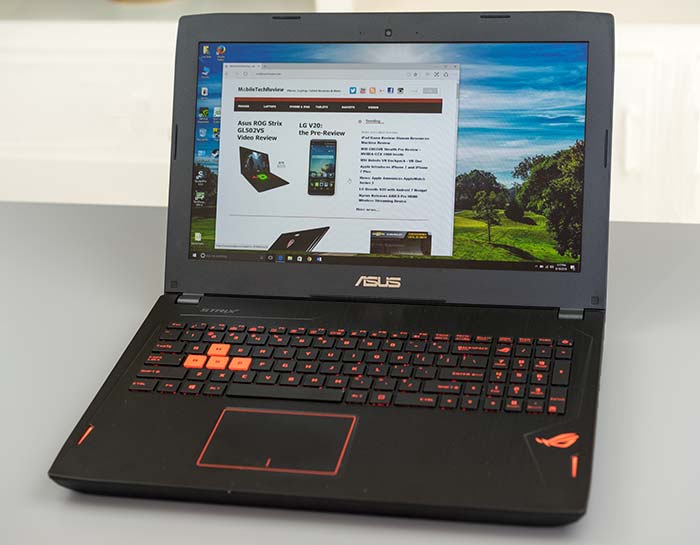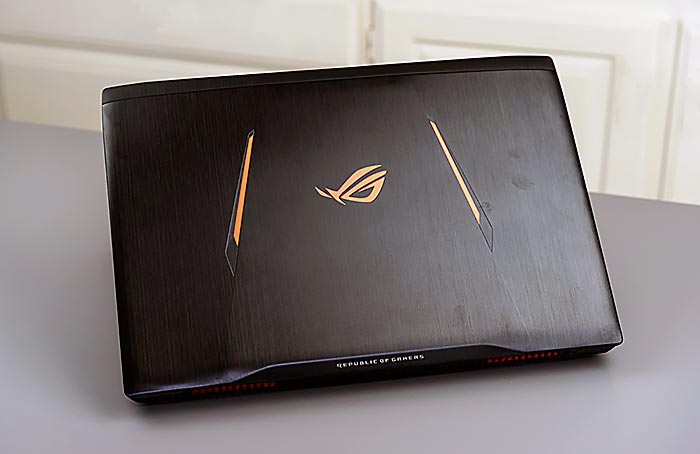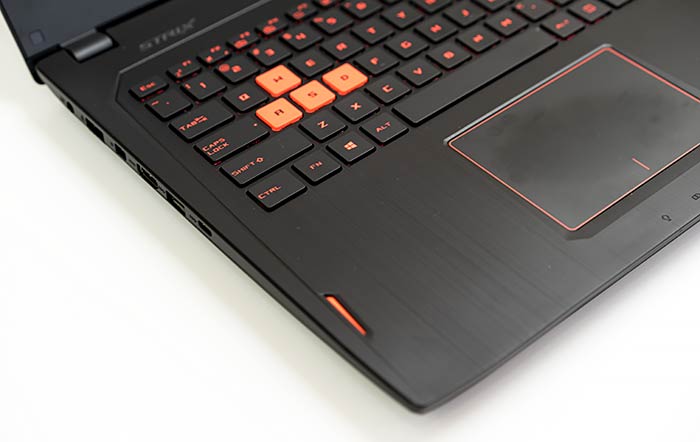|
Say hello to my new little friend, the 15.6" Asus ROG Strix GL502VS. He's a little heavier and chubbier around the middle than my previous even littler friend (the 15.6" MSI GS60 Ghost Pro). I'm OK with that: like everyone else I appreciate keen portability, but my trusty Ghost Pro (now rebadged as the smaller of two Stealth Pro models) got hot enough on the bottom when gaming to give my bare legs a sunburn. The fan noise was sometimes sufficient to require headphones, despite pretty loud speakers. If I weren't an ardent gamer, the heat and noise wouldn't have gotten to me after a year, because nothing drives a machine hard like gaming. To the MSI's credit, it troopered through with nary a hardware problem. It's a great machine, but I feel like I've been there and done that with impossibly thin yet powerful gaming laptops (until technology breakthroughs bring down the heat). The Asus' fans are loud when gaming hard, but not as loud as super-skinny gaming laptops and the bottom doesn't get painfully hot.
Before you think the Asus is a krogan among salarians (Mass Effect-speak for a sumo wrestler among geckos), let me tell you it's not. It's a pretty impressively portable 15.6" gaming laptop with a very high end NVIDIA GTX 1070 graphics card (oddly, the 17" GL702VS is only available with the GTX 1060). It weighs just 5.5 lbs. (asus claims 5,but our digital scale says 5.5) and is 1.18" thick (the 15" MSI GS63VR Stealth Pro that replaced the Ghost Pro is 0.78" and 4 lbs.). In a world where many really decked out 15" gaming laptops like the Alienware 15 are a mind-boggling 8 lbs., this ROG is a very portable machine.
I know some of you travel all the time and shaving off a pound and 0.4" is stupendous. I don't use this as my primary travel machine, so I'm OK with a little more weight and the bonus of faster graphics. Take away: look to your own needs when deciding. It's nice to have choices, confusing though it might be when you first start shopping.

Who's it For?
Those who need a very high performance notebook in a seriously portable package. Gamers, video editors and hardcore Adobe CC jockeys who use lots of plugins. College students who need decent portability and the horsepower to game in their dorm rooms. If you think the Dell XPS 15 is really cool but it can't keep up with your latest gen AAA titles, the ROG won't be as pretty and classy, but its graphics walk circles around the XPS 15. That said, if the classy XPS 15 is your thing, also consider the more powerful 14" Razer Blade, which should be shipping with NVIDIA GTX 1060 graphics in October 2016.
Who Isn't it For?
The ROG (Republic of Gamers) Strix GL502 is orders of magnitude overkill if you just play Minecraft and edit family photos and videos for fun. If you need long battery life, high end gaming laptops in general aren't a good choice, and the GL502VS' battery life isn't great especially because it doesn't switch to integrated graphics. If you want a touch screen or a glossy display, this isn't your machine. Though I really like the orange accents, it may not be to your taste and it will grab a bit of attention at work.
Specs at a Glance
The GL502VS is a significant refresh from the initial launch model that came out earlier this year. In terms of specs and materials it sits above the ASUS ROG GL552, and is the smaller alternative to Asus' flagship 17" ROG G752. Asus tweaked the design a little bit and added a second RAM slot inside. But the most important is the move to NVIDIA Pascal generation graphics for a mind-boggling 40% (and sometimes higher) improvement in graphics performance. We look at the high end $1,699 model, the GL502VS-DB71. We expect a lower end $1,399 config to hit the market with the GTX 1060 and no SSD, as well as a "DS" model with a 4K display rather than our 1080p panel.
Our GL502VS-DB71 model has Intel's 45 watt, quad core Skylake Core i7-6700HQ 6th generation CPU, same as most high end gaming laptops. It has 16 gigs of DDR4 RAM as one SODIMM RAM module, which means the other slot is open if you wish to upgrade (no need to throw existing RAM away). It ships with the NVIDIA GTX 1070 8GB DDR5 dedicated graphics and a 1920 x 1080 matte IPS display with G-Sync at 60Hz. It has a red backlit keyboard, a very fast 256 gig PCIe NVMe M.2 SSD drive and a 1 TB 7200 RPM HDD. Those are impressive parts and specs for the price. It has plenty of ports including Ethernet, mini DisplayPort and the once rare HDMI 2.0 port to drive a 4K display at 60Hz. It has USB-C Gen. 2 (the faster USB-C standard) but not Thunderbolt 3.

Build, Keyboard, Trackpad and Upgrading Internals
Like many gaming laptops in this price range, you get an aluminum lid and rugged polycarbonate base. The wrist rest is faux brushed black aluminum (actually plastic) and the lid is actual brushed black aluminum that's a dead ringer for MSI's gaming laptops. There's no chassis or lid flex. It might not be MacBook Pro chic, but it's a sturdy laptop that's very well put together with no hints of corner-cutting to save money.
The bottom lid is affixed with Phillips head screws and the entire bottom panel comes off, granting easy access to both RAM slots, M.2 SSD slot, 2.5" drive bay, Intel 8260AC wireless card, fans, battery and everything else. Well done, Asus. Upgrades are super-easy, though the components are so well-spec-d that I don't foresee wanting to immediately change components other than the 2.5", 7200 RPM HDD. Sure, that's a fast HDD, but an SSD would make for much quicker game load times and 2.5" SSDs are reasonably priced these days.
The keyboard is very good-- it has 1.6mm of key travel, anti-ghosting, a crisp and damped feel and even red backlighting (no chroma multicolored backlighting). I've typed several reviews on it, and I really like it. Since there's a number pad, the trackpad is offset from dead center and is instead centered under the spacebar. That's typical for laptops with number pads, but it might take you a while to adjust. Speaking of the trackpad, it's extremely well-behaved thanks the Microsoft Signature drivers. It tracks perfectly and multi-finger gestures work well.

Heat and Noise
The machine has two large fans with bold reddish-orange grilles. This traditional cooling design works well, and the non-crazy skinny design means it never gets burning hot on the bottom. Oddly, the 17" GL702 has a third small fan that seems to not work as well as the simpler design on our GL502. The wrist rest and keyboard area don't get hot. The hotspot on the bottom rear center exceeds human body temperature when gaming (112F in Dallas where it's still hot). That's significantly cooler than MSI's skinny competition, but hotter than bigger and thicker laptops like the MSI GT62 Dominator 15.6" model or Asus' own 17.3" ROG G752. Happily, that 112F area is between your legs if you're gaming with it on your lap, so you won't contact it. That spot's not hot enough to feel burning hot, but it will feel uncomfortable. When doing most anything else (productivity work, streaming video, Photoshop), the machine is much cooler--comfy enough for lap work and quiet enough too. When gaming, the fans are loud, though quieter and less strident than the Razer Blade and 15.6" MSI Stealth Pro. That's a good thing, because the upward firing stereo speakers on the wrist rest area are pretty wimpy (shame on you, Asus). The laptop runs much quieter when gaming if placed on a passive laptop cooler that provides more ventilation space underneath-- something like the Targus Chill Matt with its open lattice plastic surface. CPU and GPU temperatures are similar to other 15" gaming laptops-- 50-65C for the CPU (most often closer to the lower number since most games don't tax the CPU) and 70-75C for the GPU.
|
|

